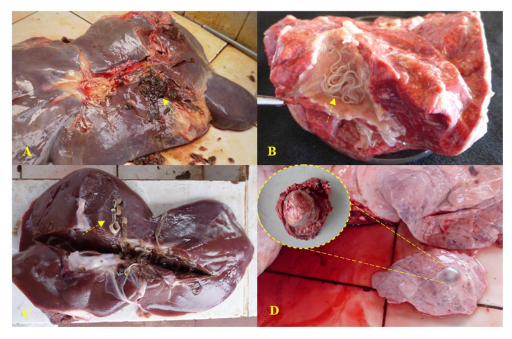Helminths and economic losses due to condemnation of food animals in Cajamarca, Peru
Main Article Content
Abstract
Under optimal environmental conditions for animal husbandry, parasites that adversely affect animal productivity also thrive. This study evaluated the presence of parasites and estimated economic losses due to the condemnation of viscera from cattle, sheep, and swine, which were slaughtered in Cajamarca, Peru. Viscera and carcasses from 2,810 cattle, 3,267 sheep, and 3,858 pigs were inspected. In cattle, Fasciola hepatica was found in liver (77.54 %), hydatid cyst in liver (0.18 %) and lung (0.07 %) and Dictyocaulus spp. in lung (0.04 %). In sheep, F. hepatica (50 %), hydatid cyst (0.03 %), Thysanosoma actinioides (0.10 %) and Cysticercus tenuicollis (0.12 %) were found in the liver. In swine, F. hepatica was found in liver (2.64 %), lesions by Ascaris suum (12.36 %) and C. tenuicollis (0.75 %), hydatid cyst in liver (0.16 %) and kidney (2.72 %), Cysticercus cellolosae in carcass-tongue-heart (0.05 %) and Metastrongylus spp. in lung (1.48 %). Total economic losses per species were USD 28,971.90 in cattle (annual economic loss [AEL]: 173,831.38), USD 4,051.30 in sheep (AEL: 24,307.79), and USD 2,013.90 in swine (AEL: 12,083.39). Total losses attributable to F. hepatica amounted to USD 33,184.89 (AEL: 199,109.32), A. suum to USD 1,191.63 (AEL: 7,149.80), C. cellulosae to USD 354.78 (AEL: 2,128.67), hydatid cysts to USD 287.70 (AEL: 1,726.22), T. actinioides to USD 7.43 (AEL: 44.57), Dictyocaulus spp. to USD 5.54 (AEL: 33.22), Metastrongylus spp. to USD 3.71 (AEL: 22.24), and C. tenuicollis to USD 1.42 (AEL: 8.52). The overall economic loss across all three species totaled USD 35,037.09 (AEL: 210,222.56). It was concluded that F. hepatica was highly prevalent and caused the greatest financial losses in cattle and sheep, while A. suum led to significant losses in swine. The presence of hydatid cysts and C. cellulosae represents a public health concern.
Article Details

This work is licensed under a Creative Commons Attribution-NonCommercial 4.0 International License.
National Center for Animal and Plant Health (CENSA)References
Strydom T, Lavan RP, Torres S, Heaney K. The Economic Impact of Parasitism from Nematodes, Trematodes and Ticks on Beef Cattle Production. Animals. 2023;13(10): 1599. https://doi.org/10.3390/ani13101599.
Rashid M, Rashid MI, Akbar H, Ahmad L, Hassan MA, Ashraf K, et al. A systematic review on modelling approaches for economic losses studies caused by parasites and their associated diseases in cattle. Parasitology. 2019;146(2): 129-141. https://doi.org/10.1017/S0031182018001282.
Titcomb G, Mantas JN, Hulke J, Rodriguez I, Branch D, Young H. Water sources aggregate parasites with increasing effects in more arid conditions. Nature Communications. 2021;12(1): 7066. https://doi.org/10.1038/s41467-021-27352-y.
Patz JA, Graczyk TK, Geller N, Vittor AY. Effects of environmental change on emerging parasitic diseases. International Journal for Parasitology. 2000;30(12-13): 1395-1405. https://doi.org/10.1016/S0020-7519(00)00141-7.
Kołodziej-Sobocińska M. Factors affecting the spread of parasites in populations of wild European terrestrial mammals. Mammal Research. 2019;64(3): 301-318. https://doi.org/10.1007/s13364-019-00423-8.
Lee S, Alkathiri B, Kwak D, Lee SM, Lee WK, Byun JW, et al. Distribution of Gastrointestinal Parasitic Infection in Domestic Pigs in the Republic of Korea: Nationwide Survey from 2020-2021. The Korean Journal of Parasitology. 2022;60(3): 207-211. https://doi.org/10.3347/kjp.2022.60.3.207.
Thanasuwan S, Piratae S, Thaowandee K, Amporn C. Prevalence and diversity of gastrointestinal parasites on pig farms in Kalasin Province, Thailand. Veterinary World. 2024;17(2): 273-281. https://doi.org/10.14202/vetworld.2024.273-281.
Băieş MH, Boros Z, Gherman CM, Spînu M, Mathe A, Pataky S, et al. Prevalence of Swine Gastrointestinal Parasites in Two Free-Range Farms from Nord-West Region of Romania. Pathogens. 2022;11(9): 954. https://doi.org/10.3390/pathogens11090954.
Mehmood K, Zhang H, Sabir AJ, Abbas RZ, Ijaz M, Durrani AZ, et al. A review on epidemiology, global prevalence and economical losses of fasciolosis in ruminants. Microbial Pathogenesis. 2017;109: 253-262. https://doi.org/10.1016/j.micpath.2017.06.006.
Arbabi M, Nezami E, Hooshyar H, Delavari M. Epidemiology and economic loss of fasciolosis and dicrocoeliosis in Arak, Iran. Veterinary World. 2018; 1648-1655. https://doi.org/10.14202/vetworld.2018.1648-1655.
Torrel S, Rojas-Moncada J, Saldaña K, Silva M, Gallardo I, Cadenillas R del P, et al. Trematodos del ganado vacuno lechero al pastoreo en Cajamarca, Perú: Fasciola hepatica y Calicophoron microbothrioides. Revista de Investigaciones Veterinarias del Perú. 2023;34(4): e24296. https://doi.org/10.15381/rivep.v34i4.24296.
Hildreth MB, McKenzie JB. Epidemiology and Control of Gastrointestinal Nematodes of Cattle in Northern Climates. Veterinary Clinics of North America: Food Animal Practice. 2020;36(1): 59-71. https://doi.org/10.1016/j.cvfa.2019.11.008.
Navarre CB. Epidemiology and Control of Gastrointestinal Nematodes of Cattle in Southern Climates. Veterinary Clinics of North America: Food Animal Practice. 2020;36(1): 45-57. https://doi.org/10.1016/j.cvfa.2019.11.006.
Stromberg BE, Gasbarre LC, Ballweber LR, Dargatz DA, Rodriguez JM, Kopral CA, et al. Prevalence of internal parasites in beef cows in the United States: Results of the National Animal Health Monitoring System’s (NAHMS) beef study, 2007-2008. Canadian journal of veterinary research = Revue canadienne de recherche veterinaire. 2015;79(4): 290-295. http://www.ncbi.nlm.nih.gov/pubmed/26424909.
Lopes LB, Nicolino R, Capanema RO, Oliveira CSF, Haddad JPA, Eckstein C. Economic impacts of parasitic diseases in cattle. CABI Reviews. 2016;10: 1-10. https://doi.org/10.1079/PAVSNNR201510051.
Rizwan HM, Zohaib HM, Sajid MS, Abbas H, Younus M, Farid MU, et al. Inflicting Significant Losses in Slaughtered Animals: Exposing the Hidden Effects of Parasitic Infections. Pathogens. 2023;12(11): 1291. https://doi.org/10.3390/pathogens12111291.
Alene D, Maru M, Demessie Y, Mulaw A. Evaluating zoonotic metacestodes: gross and histopathological alterations of beef in north-west Ethiopia one health approach for meat inspection and animal management. Frontiers in Veterinary Science. 2024;11: 1411272. https://doi.org/10.3389/fvets.2024.1411272.
Bica RFP, Copetti MV, Brum MCS. Hydatidosis, cysticercosis, and tuberculosis rates in bovine slaughtered under state sanitary inspection in Rio Grande do Sul, Brazil. Ciência Rural. 2018;48(8): e20170811. https://doi.org/10.1590/0103-8478cr20170811.
Vaisi-Raygani A, Mohammadi M, Jalali R, Salari N, Hosseinian-Far M. Prevalence of cystic echinococcosis in slaughtered livestock in Iran: a systematic review and meta-analysis. BMC Infectious Diseases. 2021;21(1): 429. https://doi.org/10.1186/s12879-021-06127-2.
